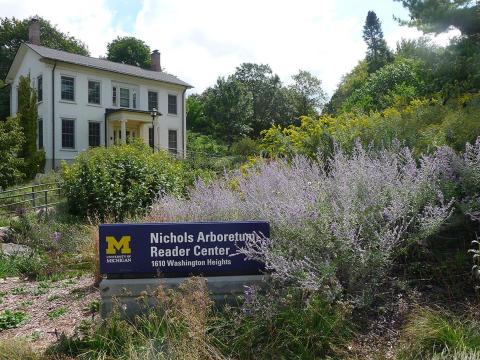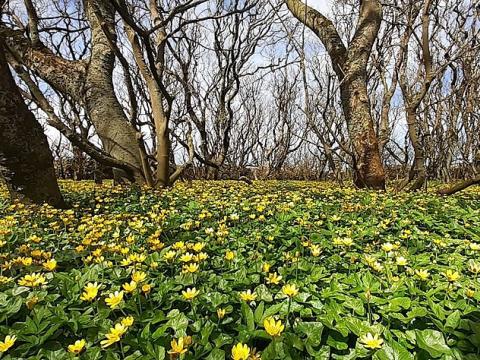
Doug Conley
Perhaps you’ve considered gardening purely a pastime for the warmer months—carefully planting your garden in the spring, working soil under the summer sun, and harvesting in the fall. What about the hushed winter season though—the under-appreciated time of year that wraps the landscape in a snowy blanket, seemingly bringing nature to a standstill?
“Anyone who thinks that gardening begins in the Spring and ends in the Fall is missing the best part of the whole year; for gardening begins in January with the dream.” This quote from Josephine Nuese reminds us that gardening, far from being a hobby only suited to temperate weather, is a full-year engagement.
We interviewed Doug Conley, our Horticulture Lead at MBGNA, to gain a deeper understanding of how this philosophy shapes work in Matthaei Botanical Garden’s outdoor spaces.
Can you tell us a little bit about how you interpret the quote: “Anyone who thinks that gardening begins in the spring and ends in the fall is missing the best part of the whole year; for gardening begins in January with the dream”?
What a lovely quote! Dreaming of our garden allows us to savor the short days, gray skies, and cold temperatures of January in northern climates.
Throughout my public gardening career, friends and family ask “what do you do in the winter?” My response has evolved over the years but at its core, it remains the: rest and recover, study and plan, clean and sharpen because when February 1 arrives, it may as well be March, which means garden cleanup!
So, a career in gardening and hanging out with garden “junkies”, I ascribe to the author and landscape architect Elizabeth Lawrence’s quote “The garden year has no beginning and no end.”
In your role as a Horticulture Lead at MBGNA, what kind of winter preparations are you and your team involved in for the upcoming planting season?
I was just in the Hort Hallway and passed Paul, MBGNA’s Display and Greenhouse Horticulturist, sorting seed packets and finalizing crop productions schedules to ensure we have the plants to implement garden plans, completed last November for 2024! Paul has already ordered potting soils, pots, and the other items needed to produce plants for display and Mother’s Day plant sale. Next up is sowing, transplanting, printing labels and similar.
At the same time, Mike, MBGNA’s Conservatory and Collections Horticulturist, is removing the Aurora exhibit from the conservatory, has produced materials for UMich botany classes hosted at the botanical garden, and is working with faculty partners to expand displays in our Broader Impacts Garden.
And, Jack, MBGNA’s Bonsai Specialist, is pruning, shaping, and cleaning trees and will soon start repotting plants in anticipation of the growing season. Also, he just switched out the tropical bonsai display in the conservatory.
I just shared with Tony, MBGNA’s director, that this may have been the busiest December and January in my career, in part due to the excitement of the Aurora exhibit, supporting projects including a bonsai winter storage space and the Maged Perennial Garden sculpture installation, and hiring staff including a new full time Native Plant Gardens Horticulturist and two Horticulture Technicians. Next up is student staff and preparing for the volunteers!
Can you highlight some of the winter preparations that align with our commitment to sustainability and climate-forward practices?
We have some work to do here like moving from potting soils that include peat, reducing reliance on plastics, and improving MBGNA’s composting practices.
That said, we have shortened our crop production schedules by starting seeds and receiving plugs later in the winter. Most importantly, this reduces water use because we are finishing the crop closer to the planting/selling date…we used to have finished crops in late April when plant sales were 2 weeks away and planting dates at least a month out.
Additionally, MBGNA has long followed Integrated Pest Management (IPM) principles, which emphasize using good cultural practices to grow healthy plants and to minimize pest and disease pressure.
For home gardeners who are eagerly awaiting spring, what recommendations do you have for them to make the most of the winter months in terms of planning and getting ready for their own gardens?
For Julie, my wife, and I, this time of year goes beyond skimming seed and flower catalogs to include watching home and garden renovation projects on tv and surfing the internet for garden inspiration and ornaments.
Our garden is divided into zones based on its general use or location: Pondside, Orchard/Farm side, the Meditation or Secret Garden, the Arrival Garden, and the Courtyard Entry garden. Each has evolved over time and an evening or weekend will include sending a link or proposing “…I believe this fountain would be lovely in Courtyard, what do you think?” or “…the azaleas under the pines need companions, how about a witchhazel?”
And, occasionally, we pour a beverage of choice, put on our boots, and walk the yard with Doug the Dog (yep!) to inspect, discuss, and dream…


